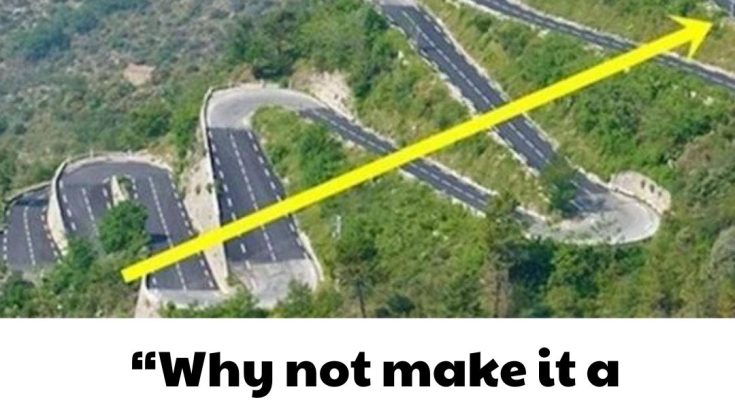The answer is straightforward: it’s to protect the lives of pedestrians and make it easier for them to ascend steep slopes. Throughout history, humans have always faced challenges when building roads, particularly those that traverse difficult terrains like mountains. These roads, often essential for trade, travel, and connecting communities, required ingenious methods to ensure they were navigable and safe.
In the past, when constructing roads that climbed to the tops of mountains, people would often rely on the help of animals, particularly donkeys. The donkey would be led to the base of the slope and allowed to ascend on its own, charting a natural path to the top. This was not a random choice—donkeys have an innate ability to find the most stable and gradual route, which minimized the risk of accidents or collapses. By following the path chosen by the donkey, builders could identify the safest way to carve a road up the slope.

This practice highlights the close relationship between humans and animals in overcoming natural obstacles. Donkeys, known for their surefootedness and ability to traverse rugged terrains, became indispensable partners in road-building endeavors. Their movements were dictated by instinct, helping them avoid dangerous paths while finding the easiest routes for their load-bearing capabilities. It was a practical solution that relied on the animal’s natural talents, saving human labor and reducing risks during the initial exploration phase.
Over time, this traditional method influenced the design of roads in mountainous regions. Early road builders recognized that the paths identified by donkeys were not only the safest but also the most efficient. These routes required less excavation and leveling, which meant they could be completed faster and with fewer resources. The result was a series of winding, zigzagging roads that mirrored the path originally chosen by the donkeys. Even today, many old mountain roads retain this characteristic design, a testament to the ingenuity of early builders and their reliance on animal instincts.
The use of animals in construction was not limited to donkeys. In some parts of the world, other animals like mules and horses played similar roles. However, donkeys were particularly favored for their resilience and ability to navigate challenging landscapes. Their contributions extended beyond road building—they were also used to transport materials and supplies, further demonstrating their importance in human endeavors.
As societies evolved and technology advanced, the methods for building roads improved significantly. Modern engineering techniques have replaced the need for animals in road construction, but the principles remain the same. Engineers today use advanced tools and machinery to survey terrain, identify the most stable paths, and design roads that ensure safety and accessibility. Despite the technological advancements, the lessons learned from relying on animals like donkeys are still relevant. The importance of considering the natural flow of the land and working with, rather than against, nature is a principle that continues to guide modern road construction.
The story of using donkeys to build mountain roads is more than just a historical anecdote—it reflects the resourcefulness and adaptability of human societies. It shows how people have always sought practical solutions to overcome challenges, using the tools and resources available to them. In this case, the tool happened to be a living, breathing animal with instincts finely tuned to its environment.
Beyond the practical benefits, there’s also a symbolic aspect to this practice. It underscores the importance of collaboration between humans and nature. The relationship between humans and donkeys was one of mutual reliance: humans provided care and shelter, while the donkeys contributed their labor and instincts. This partnership serves as a reminder of how interconnected we are with the natural world and the value of respecting and utilizing its gifts responsibly.
Today, as we drive on paved mountain roads or hike along well-trodden trails, it’s easy to take these pathways for granted. Yet, each of these roads has a story, often rooted in the ingenuity and determination of those who came before us. The winding curves and gradual slopes we experience today are the result of countless hours of labor, careful planning, and, in some cases, the instinctive wisdom of a humble donkey.
The legacy of these early road-building methods can still be seen in many parts of the world. In rural or remote areas, where modern machinery is unavailable or impractical, animals like donkeys are still used to explore terrain and transport supplies. This continuity between past and present highlights the enduring value of traditional knowledge and practices.
In reflecting on this story, we are reminded of the importance of adaptability and creativity in problem-solving. The challenges faced by early road builders were daunting, yet they found solutions that worked with the resources at their disposal. Their reliance on donkeys was not just a matter of convenience—it was a demonstration of their ability to recognize and harness the strengths of the natural world.
As we navigate our own challenges today, there’s much we can learn from their example. Whether it’s finding innovative ways to address modern problems or remembering the importance of working in harmony with nature, the lessons of the past remain relevant. The story of donkeys and mountain roads is a testament to human ingenuity and the enduring bond between people and the natural world.
So, the next time you find yourself driving along a winding mountain road, take a moment to appreciate the history behind it. Consider the ingenuity of those who built it and the role that a small, surefooted animal played in shaping the path you travel. It’s a story of collaboration, innovation, and respect for the land—a story that reminds us of the incredible achievements that are possible when we work together, with nature as our guide.



